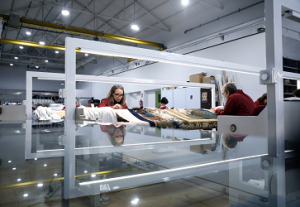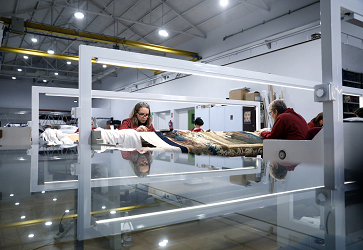Fundación Iberdrola España will be lighting up the restoration work on the Royal Tapestry Factory using the most advanced LED technology
Fundación Iberdrola España and the Royal Tapestry Factory have completed work on the lighting system in the restoration workshop of this institution, which was founded at the beginning of the 18th century by King Philip V, concluding a comprehensive transformation process using the most advanced LED technology in line with the workshop’s needs and importance.

The most advanced LED technologies had been used, ensuring the sustainability of the installation.
The director of the Iberdrola Spain Foundation, Ramón Castresana, and the director of the Royal Tapestry Factory, Alejandro Klecker, visited the workshop’s new lighting system, which is set to reduce electricity consumption by over 47%, saving almost 3.5 tonnes of CO2 emissions a year. Accompanying them on the tour of the workshop was Antonio Sama, custodian of the Royal Tapestry Factory.
During the visit, Ignacio Galán explained that the work undertaken in the Royal Tapestry Factory is part of the lighting programme carried out by Iberdrola through its Foundation in Spain, and is part of the company’s commitment to the economic and social development of all the territories in which it operates.
“With this modern equipment providing the same level of intensity in all areas of the work undertaken in the workshop, the restorers have been able to appreciate the details in each of colours sewn into tapestries over 500 years ago,” Castresana remarked, referring to the Flemish tapestries in Valencia’s Colegio del Patriarca collection.
Cutting edge LED technology
Ramón Castresana also highlighted the fact that the most advanced LED technologies had been used, ensuring the sustainability of the installation. This was one of Iberdrola’s priorities, a sign of the company’s unswerving commitment to the environment and the fight against climate change.
Alejandro Kleker said that “in terms of the transformation process that the Royal Tapestry Factory’s restoration workshop has undergone, the most important part is the new lighting system. Previously people worked in conditions that, frankly speaking, were awful.” He added, “we have resolved the issue of ambient lighting and the illumination of people’s working spaces with a new LED light design that ensures restorers’ eye fatigue is reduced to a minimum.”
For the director of the Royal Tapestry Factory, this ground-breaking technological solution “will set a precedent in the restoration world, as there are not many factories, and even fewer in the textile sector, that have a lighting system like this one.”
Antonio Sama, the custodian of the Royal Tapestry Factory said that the new system was “ideal for conserving the textiles that we work with, and saving energy. This will all lead to increased efficiency and improved conservation conditions for the pieces we handle.”
In 2017, Iberdrola and the Royal Tapestry Factory signed an agreement to replace the lighting system in the restoration workshop, continuing a partnership that began in 2013 with the restoration of the Patriarca tapestries, a series of large drapes from the early 16th century that were donated by the Real Colegio de Corpus Christi in Valencia.
For the workshop lighting project, Iberdrola installed a total of 28 sustainable energy-efficient LED, lamps which have been suspended from the ceiling, significantly increasing lighting levels in the room.
Lighting has been further enhanced at six work benches, through the design and assembly of made-to-measure metal structures that ensure colour rendition in excess of 98%, and over 80% light uniformity. These structures also allow lighting levels to be adjusted depending on the needs of each restorer.
Previously the lighting consisted of 28 halogen and eight fluorescent lights with a total power of 11,488 W. The new system has helped reduce consumption by more than 47%.
Finally, a new lighting system has been installed in the Dyeing Room, featuring 12 LED lamps which provide the same colour temperature and rendition as in the workshop.
About the Royal Tapestry Factory
Founded in 1721, the Royal Tapestry Factory has 300 years of experience in the production and restoration of tapestries, carpets, and ornamental embroidery.
In the early 18th century, the Factory was the European benchmark for luxury fabrics, thanks to the collaboration that existed between weavers and renowned painters, such as Goya, Mengs, and Bayeu. In 1889, Madrid’s urban expansion led to production being moved to the outskirts of the city. The chosen location was a plot of land known at the time as the Atocha olive grove and market garden, which, to this day, remains the home of the Royal Tapestry Factory.
In 1996, the institution became the Royal Tapestry Factory Foundation. The Foundation is dedicated to preserving handicrafts, the conservation and restoration of Spain’s textile heritage, and the general promotion of all cultural activities that raise awareness of the art of tapestry.
Fundación Iberdrola España’s commitment to culture
Iberdrola undertakes projects at artistic monuments and unique buildings to install or improve the interior and/or exterior lighting, in order to help enhance the appreciation of historical and artistic heritage and improve the energy efficiency of these systems.

